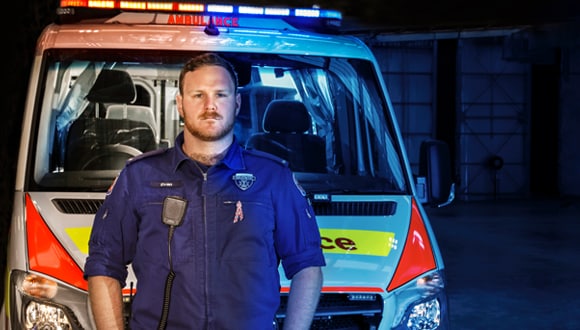Behind the scenes with a paramedic
Ever wondered what life is like for paramedics? One paramedic takes us through the skill and drama of his life-saving role.
Health Agenda magazine
March 2019
From broken bones on a rugby field to heart attacks and car crashes, paramedics witness accident and injury every day. Each shift is different, but there’s one common theme to almost every callout.
“Everyone’s happy to see a paramedic. We’re always popular and it’s a good feeling to have,” says NSW Ambulance paramedic Evan Steinle-Davies, 28.
“It’s great to be able to put a smile on your patient’s face and to relieve their pain or to provide a bit of reassurance. It’s so fulfilling.”
NSW ambulances made an average of 3,074 responses a day in 2016–17. That’s one every 28 seconds.
After 4 years with NSW Ambulance and having experienced the highs, lows and the unpredictability of the job, Steinle-Davies can’t imagine doing anything else.

Sleepless nights
Working at a large Sydney ambulance station, Steinle-Davies covers the city and northern suburbs in 12-hour shifts with 2 half-hour ‘crib’ breaks, which are a chance to get some food or sleep. Night shifts are part of the job.
“People think the night shift is cruisy, but on average we attend anywhere from 6 to 12 jobs overnight,” he says.
“And you can never tell when it’s going to be busy – it might be a Monday or a Tuesday night, you’ll be up for 12 hours, and wonder, ‘What happened to my crib?’”
A paramedic’s role
When they’re called to a job, paramedics receive brief information on a screen in the ambulance. The full picture is only revealed when they arrive.
One paramedic is the designated driver, and the other takes responsibility for treating patients; they swap roles on the next shift. Drivers take the lead in getting to the patient quickly, operating the radio and coordinating other services, while the paramedic on treating duty is mainly focused on patients.
At the hospital, paramedics wait for the patient to be triaged (prioritised for care), then it’s back to the station, ready for the next callout.
These range from life-threatening situations to issues that could have been fixed with a trip to the GP.
“Every hour is different, and I love that. You can go to a kid with croup, then an hour later, you’re dealing with a rugby accident, and the next minute you’re at a cardiac arrest,” he says.
Heartbreaking times
While paramedics appear calm on the outside, on the inside it can be a different story.
“If you have a critically injured person, or someone having a heart attack in front of you, you’re thinking, ‘What drug am I going to give? Have I spoken to the hospital? What am I going to do next?’” says Steinle-Davies.
The paramedics have to stay calm, so they don’t frighten patients and their loved ones.
If paramedics feel that a situation may be dangerous they call police, and won’t go into a building if a patient may be violent.
He finds domestic violence cases particularly challenging, but the most distressing callouts are those involving young children, especially if they’re seriously ill.
“I’ve been on a job where a 3-year-old has had a cardiac arrest and it was heartbreaking.”
A rewarding role
Trauma comes with the job and counselling is also available if needed. Steinle-Davies says talking to colleagues helps a lot.
“Every few weeks we have a breakfast BBQ at the station, which is great for a catch-up and staff morale.
It can be stressful, and our shifts are long, but we get our days off and in the end it’s a very rewarding job.”
Did you know ambulance call-out fees aren’t covered by Medicare? Read more about who pays for an ambulance in an emergency.
Need help?
Related articles
WHO PAYS FOR AN AMBULANCE IN AN EMERGENCY?
A growing number of Australians are being hit with unexpected costs for emergency ambulance call-outs. Here’s what you need to know.
FIRST AID BASICS WE SHOULD ALL KNOW
Accidents happen. Do you know how to help someone who’s injured?
HOW TO BE YOUR OWN HEALTH ADVOCATE
How being an active participant in your health care can help you live a longer, healthier life.